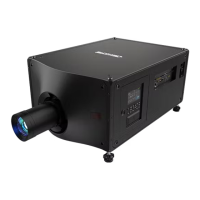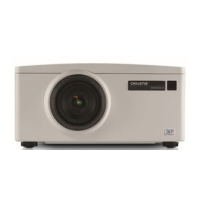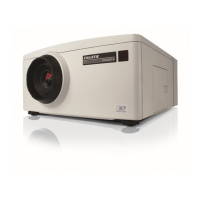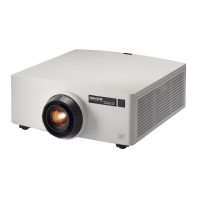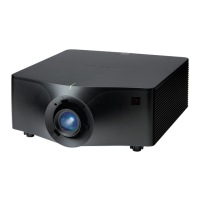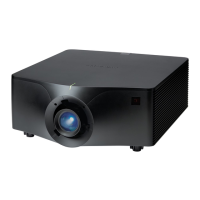Do you have a question about the Christie Griffyn Series and is the answer not in the manual?
Provides copyright details, trademark information, and general disclaimers about the document.
Outlines product warranty terms and the importance of preventative maintenance for operation.
Covers FCC compliance, RoHS, WEEE directives, and other environmental regulations.
Explains various hazard symbols (Danger, Warning, Caution, Notice, Information) used in the documentation.
Lists supported projector models and directs users to online product documentation for setup.
Lists other relevant documents available for the Christie Griffyn Series projectors.
Details critical safety precautions to prevent personal injury and device damage.
Provides essential safety and warning guidelines for operating the projector safely.
Covers safety procedures for installing the projector and connecting to AC power.
Explains laser safety precautions and defines hazardous zones and distances for safe operation.
Specifies requirements for laser-illuminated projector installations within the United States.
Describes various labels that may be found on the product.
Details general hazards like fire, shock, electrical, hot surfaces, and moving parts.
Provides a summary of the projector's capabilities and instructions for contacting a dealer.
Highlights key features, lists included components, and mentions available accessories.
Specifies minimum requirements for the installation location, including temperature and humidity.
Details the electrical power specifications for different Griffyn Series models.
Identifies the main external components of the projector.
Explains the functions of various elements on the projector's display panel.
Describes the remote control's functionality and connection options.
Lists the necessary tools for installation and setup.
Guides on preparing the installation site and safely lifting and positioning the projector.
Instructions on how to level the projector using its adjustable feet.
Step-by-step instructions for powering the projector on and off, including status indicators.
Explains the meaning of different LED states for projector status.
Describes the LED states related to the projector's shutter.
Detailed steps for installing and removing projector lenses, including calibration.
Specific instructions for installing an ultra short throw projection lens.
Guides on aligning and focusing the projected image, including boresight and offset adjustments.
Instructions for optimizing the integrator zoom and focus settings.
Procedures for adjusting the fold mirror for optimal image projection.
Guides on aligning the projected image using lens zoom and focus adjustments.
Covers both mechanical and electronic methods for adjusting digital micromirror device convergence.
Explains how to use Auto Setup to optimize display settings.
Addresses product packaging disposal and completing the installation checklist.
Identifies the ports and components of the projector's video input panel.
Covers input configuration, projector communication enablement, and remote access levels.
Guides on selecting port configurations and choosing the video source.
Details connecting HDMI sources and supported video formats (2.0 and 2.1).
Explains connecting SDI sources and lists supported video formats.
Covers connecting DisplayPort sources and supported video formats (1.2 and 1.4).
Details connecting Christie Link sources and supported video formats.
Explains connecting SDVoE sources and supported video formats.
Covers connecting HDBaseT sources and supported video formats.
Guides for connecting computers via USB and Ethernet, including setup.
Instructions for communicating with the projector using the Art-Net protocol.
Explains how to configure the 3D sync interface for 3D-enabled projectors.
Details how to configure the RS232 port for serial commands.
Covers configuring Generic Purpose Input Output pins and the GPIO connector details.
Instructions for enabling the wired remote keypad connection.
Lists hardware and software requirements for stereo 3D applications.
Illustrates a typical hardware setup for active stereo 3D systems.
Shows a typical hardware configuration for passive stereo 3D systems.
Covers optimizing 3D timing and input stream configurations.
Steps to enable 3D mode, confirm emitter setup, and configure for 3D sources.
Explains how to connect devices to the 3D sync ports for synchronization.
Lists various safety standards and regulations the product conforms to.
Details emissions and immunity requirements related to EMC.
Mentions California law regarding security features for internet-connected devices.
Outlines environmental directives such as RoHS, WEEE, and REACH.
Provides copyright details, trademark information, and general disclaimers about the document.
Outlines product warranty terms and the importance of preventative maintenance for operation.
Covers FCC compliance, RoHS, WEEE directives, and other environmental regulations.
Explains various hazard symbols (Danger, Warning, Caution, Notice, Information) used in the documentation.
Lists supported projector models and directs users to online product documentation for setup.
Lists other relevant documents available for the Christie Griffyn Series projectors.
Details critical safety precautions to prevent personal injury and device damage.
Provides essential safety and warning guidelines for operating the projector safely.
Covers safety procedures for installing the projector and connecting to AC power.
Explains laser safety precautions and defines hazardous zones and distances for safe operation.
Specifies requirements for laser-illuminated projector installations within the United States.
Describes various labels that may be found on the product.
Details general hazards like fire, shock, electrical, hot surfaces, and moving parts.
Provides a summary of the projector's capabilities and instructions for contacting a dealer.
Highlights key features, lists included components, and mentions available accessories.
Specifies minimum requirements for the installation location, including temperature and humidity.
Details the electrical power specifications for different Griffyn Series models.
Identifies the main external components of the projector.
Explains the functions of various elements on the projector's display panel.
Describes the remote control's functionality and connection options.
Lists the necessary tools for installation and setup.
Guides on preparing the installation site and safely lifting and positioning the projector.
Instructions on how to level the projector using its adjustable feet.
Step-by-step instructions for powering the projector on and off, including status indicators.
Explains the meaning of different LED states for projector status.
Describes the LED states related to the projector's shutter.
Detailed steps for installing and removing projector lenses, including calibration.
Specific instructions for installing an ultra short throw projection lens.
Guides on aligning and focusing the projected image, including boresight and offset adjustments.
Instructions for optimizing the integrator zoom and focus settings.
Procedures for adjusting the fold mirror for optimal image projection.
Guides on aligning the projected image using lens zoom and focus adjustments.
Covers both mechanical and electronic methods for adjusting digital micromirror device convergence.
Explains how to use Auto Setup to optimize display settings.
Addresses product packaging disposal and completing the installation checklist.
Identifies the ports and components of the projector's video input panel.
Covers input configuration, projector communication enablement, and remote access levels.
Guides on selecting port configurations and choosing the video source.
Details connecting HDMI sources and supported video formats (2.0 and 2.1).
Explains connecting SDI sources and lists supported video formats.
Covers connecting DisplayPort sources and supported video formats (1.2 and 1.4).
Details connecting Christie Link sources and supported video formats.
Explains connecting SDVoE sources and supported video formats.
Covers connecting HDBaseT sources and supported video formats.
Guides for connecting computers via USB and Ethernet, including setup.
Instructions for communicating with the projector using the Art-Net protocol.
Explains how to configure the 3D sync interface for 3D-enabled projectors.
Details how to configure the RS232 port for serial commands.
Covers configuring Generic Purpose Input Output pins and the GPIO connector details.
Instructions for enabling the wired remote keypad connection.
Lists hardware and software requirements for stereo 3D applications.
Illustrates a typical hardware setup for active stereo 3D systems.
Shows a typical hardware configuration for passive stereo 3D systems.
Covers optimizing 3D timing and input stream configurations.
Steps to enable 3D mode, confirm emitter setup, and configure for 3D sources.
Explains how to connect devices to the 3D sync ports for synchronization.
Lists various safety standards and regulations the product conforms to.
Details emissions and immunity requirements related to EMC.
Mentions California law regarding security features for internet-connected devices.
Outlines environmental directives such as RoHS, WEEE, and REACH.
